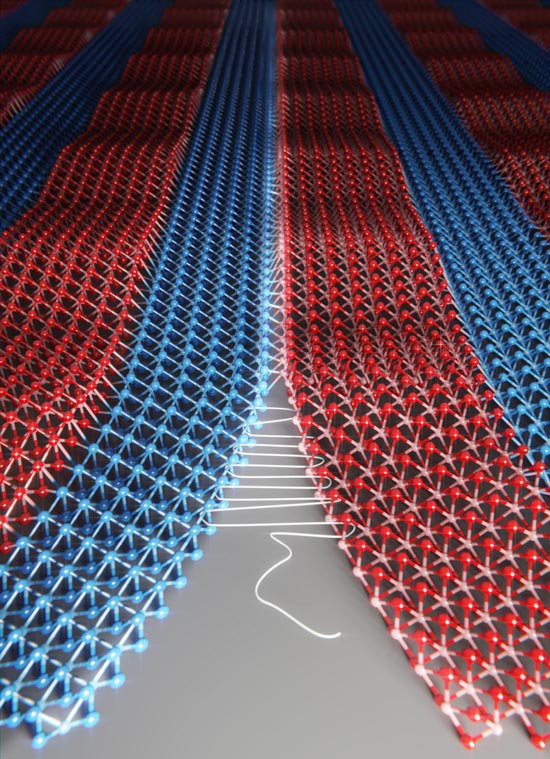Researchers sew atomic lattices seamlessly together

Scientists with the University of Chicago revealed a technique to 'sew' two patches of crystals seamlessly together at the atomic level to create atomically-thin fabrics. Credit: Courtesy Park et al
In electronics, joining different materials produces heterojunctions-the most fundamental components in solar cells, LEDs or computer chips. The smoother the seam between two materials, the more easily electrons flow across it; essential for how well the electronic devices function. But they're made up of crystals-rigid lattices of atoms, which may have very different spacing-and they don't take kindly to being mashed together.
In a study published March 8 in Science, scientists with the University of Chicago and Cornell revealed a technique to “sew” two patches of crystals seamlessly together at the atomic level to create atomically-thin fabrics.
The team wanted to do this by stitching different fabric-like, three-atom-thick crystals. “Usually these are grown in stages under very different conditions; grow one material first, stop the growth, change the condition, and start it again to grow another material,” said Jiwoong Park, professor of chemistry in the James Franck Institute and the Institute for Molecular Engineering and a lead author on the study.
Instead, they developed a new process to find the perfect window that would work for both materials in a constant environment, so they could grow the entire crystal in a single session.
The resulting single-layer materials are the most perfectly aligned ever grown, Park said. The gentler transition meant that at the points where the two lattices meet, one lattice stretches or grows to meet the other-instead of leaving holes or other defects.
The atomic seams are so tight, in fact, that when they looked up close using scanning electron microscopes, they saw that the larger of the two materials puckers a little around the joint.
They decided to test its performance in one of the most widely used electronic devices: a diode. Two different kinds of material are joined, and electrons are supposed to be able to flow one way through the “fabric,” but not the other.
The diode lit up. “It was exciting to see these three-atom-thick LEDs glowing. We saw excellent performance-the best known for these types of materials,” said Saien Xie, a graduate student and first author on the paper.
The discovery opens up some interesting ideas for electronics. Devices like LEDs are currently stacked in layers-3D versus 2D, and are usually on a rigid surface. But Park said the new technique could open up new configurations, like flexible LEDs or atoms-thick 2D circuits that work both horizontally and laterally.
He also noted that the stretching and compressing changed the optical properties-the color-of the crystals due to the quantum mechanical effects. This suggests potential for light sensors and LEDs that could be tuned to different colors, for example, or strain-sensing fabrics that change color as they're stretched.
“This is so unknown that we don't even know all the possibilities it holds yet,” Park said. “Even two years ago it would have been unimaginable.”
###
This work was carried out in collaboration with co-lead authors David A. Muller and Robert A. DiStasio Jr. at Cornell University. Other coauthors included University of Chicago postdoctoral scholars Kibum Kang and Chibeom Park and graduate student Preeti Poddar, as well as Cornell University postdoctoral scholar Ka Un Lao and graduate students Lijie Tu, Yimo Han, and Lujie Huang. The study used computing resources at the Argonne Leadership Computing Facility at Argonne National Laboratory.
Citation: “Coherent, atomically-thin transition-metal dichalcogenide superlattices with engineered strain.” Xie et. al, Science, March 8, 2018.
Media Contact
All latest news from the category: Materials Sciences
Materials management deals with the research, development, manufacturing and processing of raw and industrial materials. Key aspects here are biological and medical issues, which play an increasingly important role in this field.
innovations-report offers in-depth articles related to the development and application of materials and the structure and properties of new materials.
Newest articles

NASA: Mystery of life’s handedness deepens
The mystery of why life uses molecules with specific orientations has deepened with a NASA-funded discovery that RNA — a key molecule thought to have potentially held the instructions for…

What are the effects of historic lithium mining on water quality?
Study reveals low levels of common contaminants but high levels of other elements in waters associated with an abandoned lithium mine. Lithium ore and mining waste from a historic lithium…

Quantum-inspired design boosts efficiency of heat-to-electricity conversion
Rice engineers take unconventional route to improving thermophotovoltaic systems. Researchers at Rice University have found a new way to improve a key element of thermophotovoltaic (TPV) systems, which convert heat…



